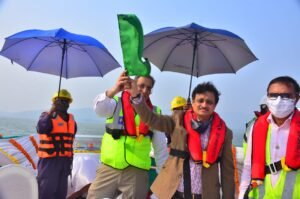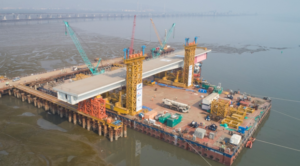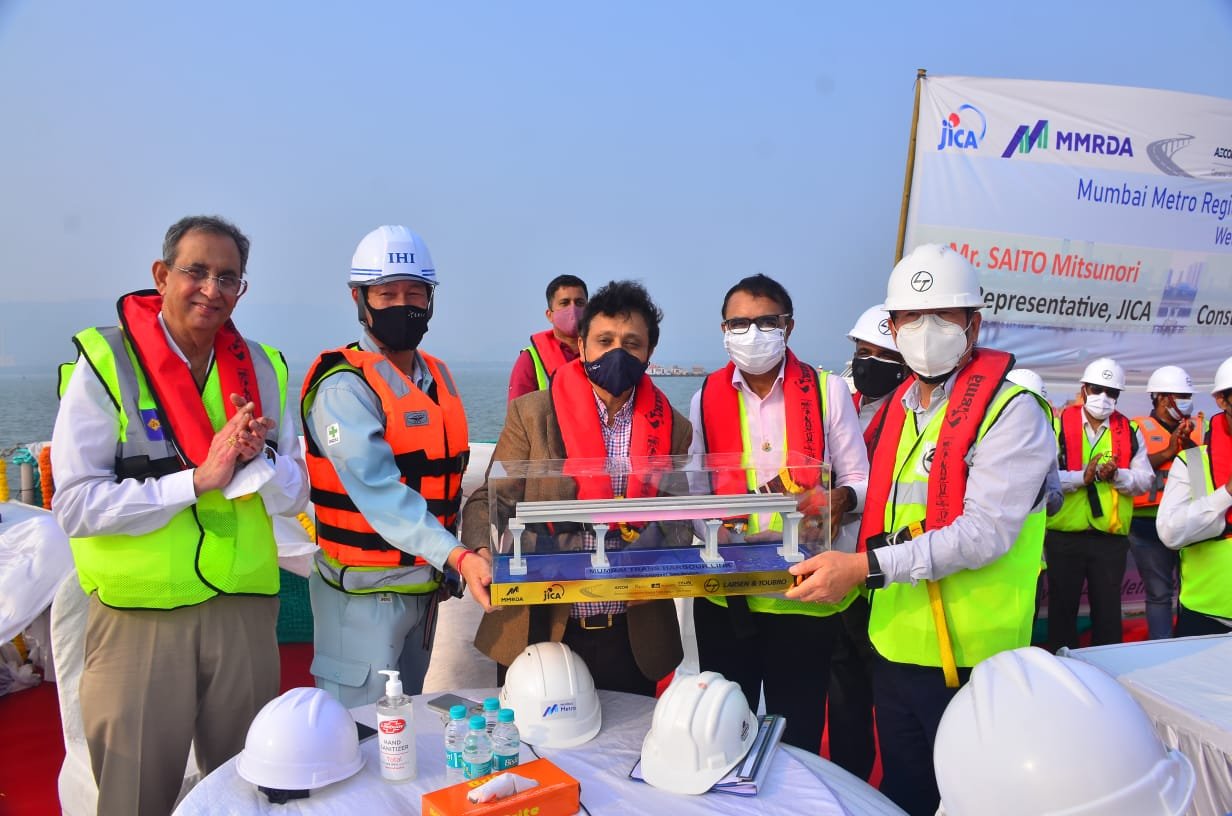The 1st Orthotropic Steel Deck (OSD) span of length 119 mtrs and weight 1331 MT launched in MTHL, Package-1
Mumbai: The Mumbai Trans Harbour Link (MTHL) has successfully completed a milestone event with one of the most complex construction activities with the erection of the Orthotropic Steel Deck (OSD) in Package-1. This Package is awarded to L&T-IHI Consortium.
Package-1 involves the construction of a 10.38 km of long bridge across the Mumbai Bay including Sewri Interchange at Mumbai Side.
About Orthotropic Steel Deck (OSD) Construction at MTHL:
The Orthotropic Steel Deck is a steel Deck Superstructure (strengthened or stiffened both transversely and longitudinally which will carry the vehicular load more efficiently among three planes and improve the load-carrying capacity of the bridge as compared to Concrete Superstructure for similar span.
OSD Steel Deck Superstructure has lesser self-weight than concrete or composite girders and a longer span of 180 mtrs is designed using OSD for this project by the Contractor (L&T-IHI Consortium).
OSD is the ideal solution considering MTHL site conditions (Navigational Channels, Discharge Channels) and longer Pier to Pier distances. It is also more cost-effective compared to the Cable Stay or Suspension bridges.
The steel spans are fabricated in fabrication workshop facilities located in Japan,Vietnam, Taiwan etc. and delivered to India which will enable faster construction work and lessen deck-related on-site activities.
The final assembly, of 1st OSD span was done in last fortnight of December 2021 and load-out /erection of the superstructure at Pier Location MP124N-125N was carried out on-site on 14th January 2022.
A barge, which was specifically designed and manufactured is being used for the transportation of these heavy Orthotropic Steel Deck (OSD) sections.
This is a flat top ballastable barge having weight of 5359 MT with 110 mtrs in length and 64 mtrs in breadth which is equivalent to size of actual football ground area. The depth of the barge is 6 mtrs with deck strength of 15 T/m2.
Shri. S.V.R. Srinivas, IAS, Metropolitan Commissioner, MMRDAsaid that “It is a major milestone & the construction of the most complex part of MTHL Project.”

About MTHL:
The Mumbai Trans Harbour Link, also known as the Sewri-Nhava-Sheva HarbourLink is an under-construction of about 22 km long, the 6-lane bridge with about 16.5km long over the sea and about 5.5kms long viaduct on land on either side. The Link has interchanges at Sewri in Central Mumbai, Shivaji Nagar at Mumbai Bay, and NH-4 B at Chirle, Navi Mumbai. The MTHL will feature approach sections, interchanges, an intelligent transport system (ITS), and the other amenities required for a sea bridge. The traffic conditions on the stretch will be monitored and managed from the traffic control Centre with the help of CCTV cameras and related facilities installed on the stretch.
The total length of spans of the OSD superstructure in both carriageways of MTHL is about 6.41 km. The width of the steel superstructure is about 14.92m for each carriageway.
The total steel quantity to be used for the OSD superstructure in MTHL will be about 87,452 MT. The span erected on 14th January 2022 has a length of 119 meters with a total weight of about 1331 Mt
This is a very important stage and it accelerates the construction of MTHL that will connect South Mumbai to the Navi Mumbai in a mere 20 minutes as compared to the current travel time of 120 minutes.

The Mumbai Trans HarbourLink (MTHL) has been identified as the important infrastructure to improve the connectivity between Mumbai and Navi Mumbai and continue economic development in Mumbai Metropolitan Region. The project cost is ₹ 17,843 crores and its 80% piers works are completed till now and the overall project is about 65% completed. The project is expected to be completed in the year 2023.

